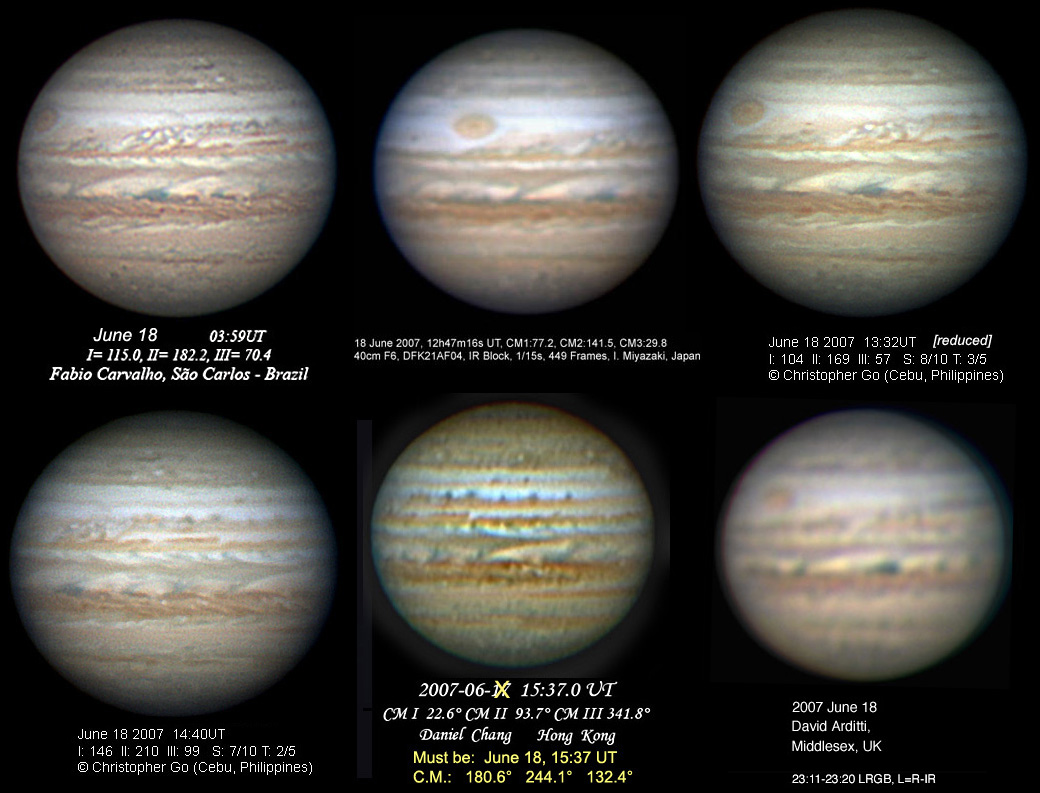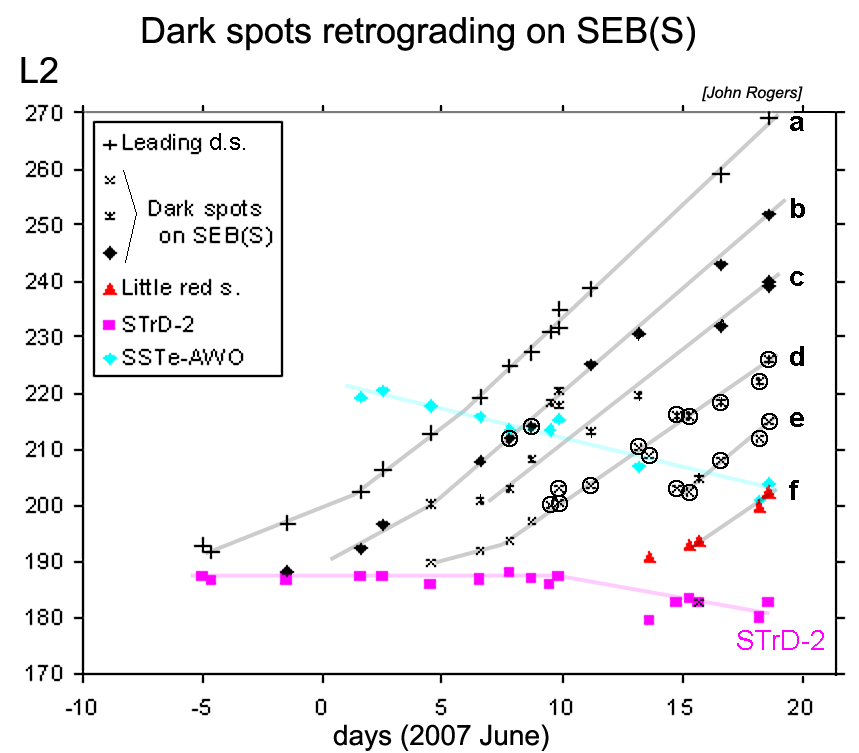| Jupiter SEB outbreak update by John H.Rogers |
Here is a chart* showing the motion of the dark spots on SEB(S) ? the southern branch of the SEB Revival. The retrograding motion is very clear, and typical for a SEB Revival. The speeds in L2 are: (a) +120; (b,c) +110; (d,e) +84 (degrees per 30 days). These speeds for (a,b,c) are typical of the SEBs jet, and we reported speeds in the same range in 2000/01 and 2001/02. The spots retrograded more slowly when they were close to the source (~ +55 to +80 deg/month); some were also notably large and southerly. Both of these properties might have been due to the adjacent STrD-2, but they were not well correlated, so they may have been simply the properties of recently-created spots. STrD-1 is at L2 = 325, slowly prograding (L3 = 213). The leading dark spot (a) is on course to encounter it on July 1. If STrD-1 still exists with a strong enough circulating current, spot (a) will flip round and might travel back in the opposite direction, in the STBn jet (or it might be torn apart). If STrD-1 is not strong enough, spot (a) will carry on retrograding, though probably with reduced speed. Therefore, it is important to get images of STrD-1 from July 1 onwards as frequently as possible ? preferably on every rotation during the first week in July. Also attached is a set of images of the SEB Revival outbreak on June 18, when it was well imaged on 3 successive rotations. Our previous bulletins and image sets about this SEB Revival outbreak have now been uploaded on our web site (address below, follow "Reports ? 2007"). *Notes on the chart: These longitude measurements were made manually by JHR, from images by Carvalho, Chang, Fattinanzi, Ghomizadeh, Go, Haese, Ikemura, Fukui, Jakiel, Lomeli, Medugno, Miyazaki, Olivetti, Parker, & Akutsu. Some of the scatter may be due to inaccuracies in timing of a few images. Dark spots on SEB(S) are labelled (a) to (f): (a) Leading dark spot, (b-e) other dark spots, (f) little red spot. The different types of crosses do not mean anything, but particularly large, southerly spots are circled. A S.S.Temperate white oval was measured as a reference point.
John H. Rogers,Ph.D. Jupiter Section Director, [British Astronomical Association.] ----------------------------------------------------------------------------------------- Japanese 更新:木星のSEB outbreak 2007年6月20日 木星メールリストの皆様へ この図はSEB(S)上の暗斑[SEB復活の南分枝]の動きを示すチャートである。 後退する動きが非常にはっきりしていて、SEB復活の典型である。第2系での 速度は、(a) +120度/月、 (b,c) +110度/月、 (d,e) +84度/月である。これ らの(a,b,c)の速度はSEBsジェット気流の典型であり、私たちは2000/01年と 2001/02年に同じ範囲の速度を報告している。 暗斑が発生源に近かった時には、暗斑はさらにゆっくりと後退した(約+55 から+80度/月)。また、それらのいくつかはとりわけ大きく、南寄りであった。 これらの特徴の両方ともが隣接したSTrD-2によるものかもしれないが、これらは うまく関連付けられなかったので、これらは単純に最近に形成された暗斑の特徴 だったかもしれない。 STrD-1はL2=325度(L3=213度)に位置し、ゆっくりと前進している。 リーディング暗斑(a)は7月1日にSTrD-1と出会うコースにある。もしSTrD-1が なおも循環気流を保つほど強く残っていれば、暗斑(a)は半円形にひっくり返り、 反対方向であるSTBnジェット気流で戻ってくるだろう(あるいは分裂するだろう)。 もしSTrD-1が十分に強くなければ、暗斑(a)はたぶん減少した速度になる けれども後退を続けるだろう。したがって、7月1日以降できるだけ頻繁に (できれば7月の第1週は全ての自転ごとに)STrD-1の画像を撮影することは 重要である。 また、添付しているのは6月18日のSEB復活の突出の画像で、これは3回の連続 した自転で撮影されたものである。 このSEB復活の突出についての以前の報告や画像は、私たちのWebサイトに 公開されている(下記のアドレスから"Reports"‐"2007"をクリック)。
●チャートについての注釈 これらの経度の計測は、Carvalho, Chang, Fattinanzi, Ghomizadeh, Go, Haese, Ikemura, Fukui, Jakiel, Lomeli, Medugno, Miyazaki, Olivetti, Parker, Akutsu各氏によって撮影された画像から、JHRがマニュアルで作成 した。分散は少数の画像の時刻の不正確さによるものかもしれない。 SEB(S)上の暗斑は(a)から(f)までのラベルを付けている。ここで (a)リーディング暗斑、(b-e)その他の暗斑、(f)小赤斑である。 異なった種類の十字記号は特に意味は無いが、特に大きくて南寄りの暗斑は 丸で囲んである。SSTBの白斑が参照点として計測されている。

ALPO-Japan Latest
Jupiter Section